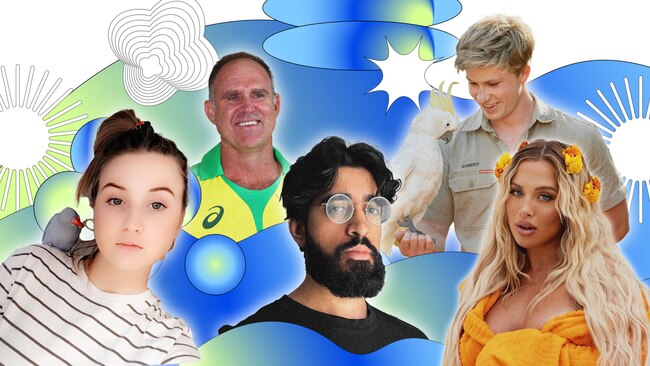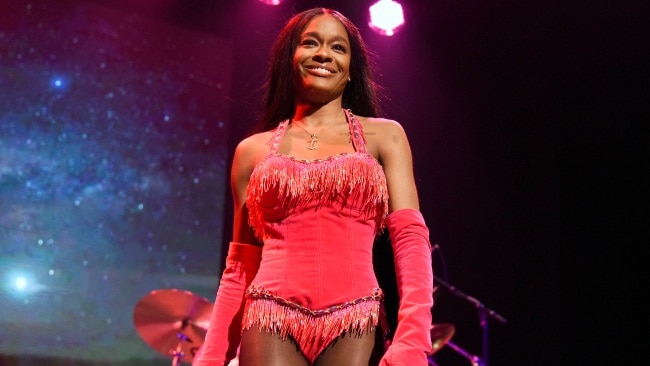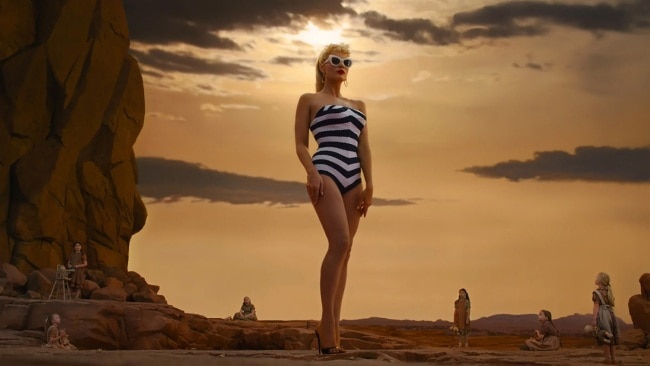Who are the top influencers?
Olivia Rodrigo walked at the White House so Australian influencers could run.

Meet the content creators that took out The Influence Index.
When the US desperately needed young people to get vaccinated against Covid-19, it wasn’t medical professionals who rallied the under-30s – it was a young singer with more than 40 million followers across Instagram and TikTok.
Dressed in a vintage pink and black Chanel suit – resembling Jackie Kennedy in her two-piece – then 18-year-old Olivia Rodrigo addressed the White House press corps urging her fans, and her countrymen and women, to get the jab. Rodrigo’s name began trending on social media after the High School Musical: The Musical series star offered to participate in government efforts to appeal to the nation’s youth – who had been getting vaccinated at lower rates than other demographics.
“I know this young person would’ve gotten vaccinated, but we’ve got to get other young people protected as well,” President Joe Biden captioned a throwback photo of his younger self. “Who’s willing to help?”
“i’m in!” Rodrigo commented in all lower case – a linguistic style popular among the young, who were reared online. “see you tomorrow at the white house!”
She then filmed short public service announcements that were published across her own and the government’s official social media channels. The result led to a spike in the youth of America getting, or wanting to get, vaccinated, which crashed the curve in Covid fatalities in mid-2021.
Therein lies the power of the influencer
Once a term derided for lowering the tone of everything from fashion and culture to politics, it’s now a legitimate career path – and medium – according to 64% of millennials and Generation Z. Indeed, 75% of young Australians follow at least one influencer – a statistic uncovered this week by research conducted for The Influence Index, a ranking of the most legitimately influential influencers in Australia published today by The Oz, The Australian’s recently launched news platform led by Generation Z.
The study, which spoke to 2000 people aged between 15 to 40, found that two-thirds had bought something because it was recommended by an influencer.
However the index, published in full on Thursday on The Oz, also pinpoints a moment of change in the social media influencer world that should come as a wake-up call – not only for marketers but also for anyone trying to get a message across to young people today.
Using unique methodology to uncover the extent of the reach of social media influencers, the inaugural list shows that influence in Australia is increasingly less about celebrity or even glamour but, rather, trust and “relatability” – Rodrigo notwithstanding.
Those social media users who can establish a connection between influencer and follower wield more market power than a pseudo-celebrity with millions more followers that can’t relate to and don’t engage with the content.
The study in real influence – the first rigorous analysis of the reach and power of social media published yet in Australia – names as the nation’s most powerful influencer 20-year-old Brisbane mother Sarah Magusara, who lives in the suburbs and publishes images and videos to her million followers in which she, mostly clad in activewear, is in her backyard, driveway or front lawn posing, doing some light exercise or running after her toddler.
She has secured deals with fast fashion and beauty labels that are hard to quantify but have given her an aspirational lifestyle and, soon, an all-expenses-paid European holiday for her 21st birthday.
The index otherwise comprises a group of diverse individuals whose ages span 13 to 50 (two of whom wrangle crocodiles), and one parrot. All have audiences of more than 10 million across several platforms such as TikTok, Instagram and YouTube. And they have snagged corporate sponsorship deals with the likes of Gucci, Red Bull, Asics and Hungry Jacks.
Twenty-five of the top 100 fall into the Gen Z generation, 19 are mothers, and those with a passion and expertise in food, dancing and fitness also made the cut.
There is not one traditional celebrity on the list.
The closest are former reality TV stars including Abbie Chatfield and Brooke Blurton.
Both have gone on to build lucrative media careers and become prominent activists for social causes such as gender equality and Indigenous reconciliation.
Nor are there many models or socialites who boast a high following and chalk up hundreds and thousands of likes and comments for their #ootf (outfit of the day) #sponcon (sponsored content) by high-end and luxury fashion and beauty brands.
Adam Worling, a leading Sydney publicist of more than 30 years, tells The Oz it is important to remember influencers have not always been revered and were treated with trepidation, especially by the fashion industry, when they emerged.
“It’s an evolution. They were bloggers, now we have influencers or taste makers and waves of them have disappeared. But there are some who turn themselves into authentic brands and thrive,” says Worling, who has worked with leading brands such as Carla Zampatti, David Jones and I.AM.GIA. Worling underscores the importance of influencers connecting with their audience, over having squillions of followers.
“I don’t care about the reach, unless there is an authentic connection I don’t care,” he says.
“Putting someone or something on a pedestal is easy; it’s keeping them there that’s the hard part. It’s about building relationships. If I’m working with influencers for something, I want to make sure they’re part of the brand in a few months’ time.
“It’s not just transactional, the goal is to build authentic relationships.”
But it’s a two-way street. He says there needs to be more regulation and transparency, especially from influencers.
“If brands and other forms of media, like magazines and mainstream media outlets, have to offer their metrics and stats, then they must as well. I mean, it’s great you’ve got all these followers and engagement, but how many units have you moved?”
Transparency is also key for Nikki Andrews, founder and director of NAC Media Group.
Andrews, who counts Dior, Saint Laurent and local labels Venroy and Bondi Born as clients, agrees that follower counts don’t automatically equate to true influence. “It all comes down to brand fit and positioning,” she says. “Someone may have a huge following but it may not be aligned to a brand and achieve the outcomes required, which are mainly conversion.
“It’s a tough game. Brands that want to invest in influencers now want details, they want transparency, they want to see back-end data – your reach, your ability to convert either sales or other outcomes like messaging or awareness.”
David Gardiner, founder of DGPR who counts a number of Perth's most popular and exclusive hospitality venues as clients, urges brands to be vigilant with the virtual due diligence.
"I see many brands and businesses taking a tokenistic approach to influencer engagement - picking those with big followers but not really diving into who they are, and the results are always the same set spruiking the wares of any business who shares a crumb with them," Gardiner tells The Oz.
"Our team spends hours diving into accounts. We are observing their accounts for weeks to ensure they are a right fit, looking at numerous metrics, not just followers and engagement. We are constantly on the hunt for real authentic people of actual influence in their markets who have developed trust of their audiences and can have a significant ROI for our brands.
"Never forget the industry talks. We regularly share our horror stories of those wrong choices, diva demands and pure arrogance – that all comes into play when we scroll through feeds. We know who whores themselves out for a freebie and so does their audience. If their brand is a business they need to treat it like that and not a red light district."
The goalposts are certainly shifting, according to Toni Eagar, a marketing specialist from the Australian National University’s college of business and economics. “Authenticity and marketing is a very new concept,” Dr Eagar says.
“People got jack of marketing and thus the influencer was born.”
Influencers who become personalities have built brands, with the power, ability and hustle to have an impact on everything we buy, to how we think and feel. Gone are the days of Googling symptoms or searching the web for makeup tips and general news – TikTok is the new search engine. Well-lit makeup tutorials are dead, we’re now living in an era of “makeup hacks” and being told to take “internal showers” by drinking chia seeds.
Young Australians are flocking to psychologists, having already self-diagnosed their illness on TikTok, leaving health practitioners to balance a welcome rise in mental health awareness with growing fears about an influx of misdiagnoses. Asperger’s, autism, Tourette’s and ADHD have their own subcultures across TikTok, Instagram and YouTube, helping young people to identify their illnesses and easing the shame that surrounds them.
While social media may never replace legitimate health advice (or wild animal husbandry – see crocodile wrangler Robert Irwin, who made the list), it is a sphere populated by people who share, educate and inspire a growing number of us, either through direct engagement by following or via automated osmosis thanks to each platform’s ever changing algorithms.
“There’s no greater expert than someone who aggregates tens of thousands of strangers purely from their social content,” Tribe creator marketing platform founder Jules Lund says.
Warts and all are a winning combination that not only incites an emotional connection but drives market power to the 21 million Australians who are scrolling, double tapping and commenting online every day.


